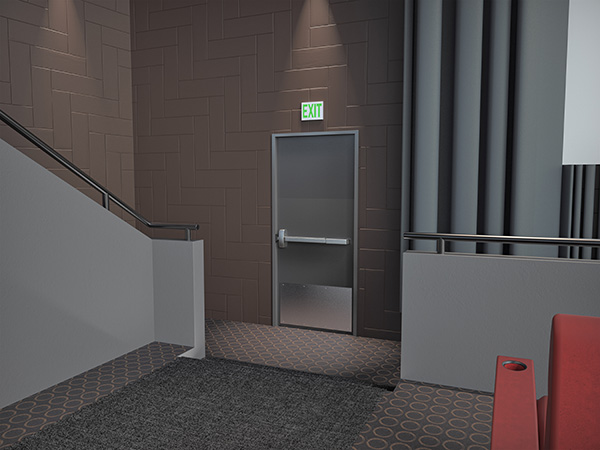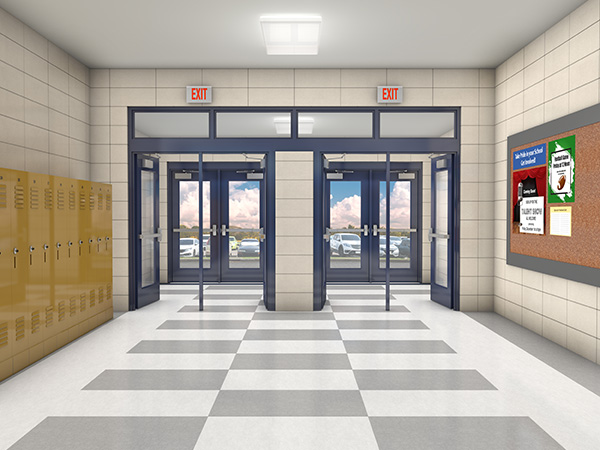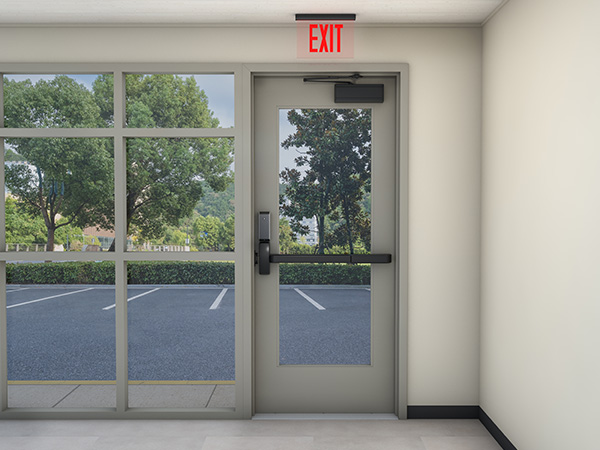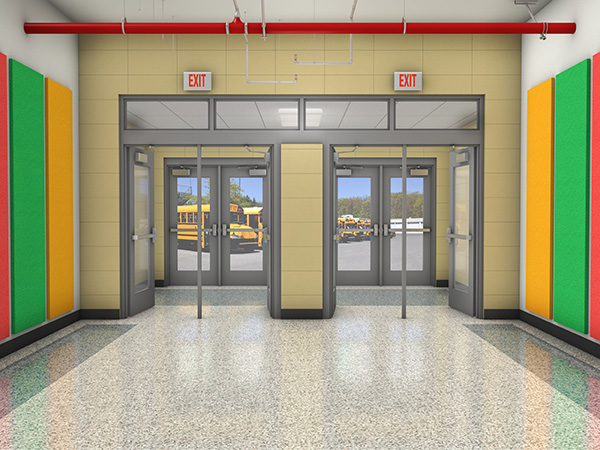SPONSORED
SARGENT - Branded Feature
Simple Door Modifications Create Complex Problems
Sometimes even the simplest, unassuming actions can wreak the most severe consequences. How many times have you encountered a door that’s propped open, or a door latch that’s been taped so it remains unsecure? These seeming innocuous modifications happen in facilities of all types, typically initiated by occupants without any malicious intent, but rather, for convenience. In reality, these actions represent a significant risk to life safety, security and compliance that typically go unnoticed until an incident occurs – and it’s too late.
Fire-rated doors stand as a critical safeguard in commercial and institutional buildings yet often go unnoticed by the people in the building. They often look the same as other doors, but their purpose goes beyond mere separation of spaces. Fire-rated door assemblies are engineered to slow the spread of fire and smoke throughout a building, providing essential protection in the event of a fire emergency. When these doors are propped open or modified to prevent proper latching, they compromise the integrity of the fire containment system, increasing the spread of fire damage and increasing the risk of loss of life. This opens organizations up to serious risks, liabilities and consequences that range from physical harm of individuals and financial damages.
So how do you prevent occupants and stakeholders from making these kinds of costly mistakes? It starts with the door assembly itself.

Understanding Fire-Rated Doors
Even though “fire-rated door” is common terminology, the fire rating actually covers the entire door assembly including the frame, hinges and pivots, closing device, and latching mechanism. All of these components comprise a fire-rated door and must all be certified for a fire protection period equal to or greater than the building’s requirement. Since door openings are comprised of many different components, the whole opening gets the rating of the component with the shortest rating.
For example, fire protection ratings are specified as 20, 45, 60, 90, or 180 minutes, denoting how long the assembly was tested to withstand a fire. So even if the door achieves a 90-minute fire-rating but is installed with an exit device rated for only 20 minutes, the opening is only rated up to 20 minutes.
Additionally, any modification that forces a fire door into an open position or prevents it from latching negates the fire rating, violating fire codes and poses a significant threat to life safety.
The National Fire Protection Association (NFPA) is a nonprofit organization that establishes code to help eliminate death, injury, property, and economic loss due to fire, electrical, and related hazards. NFPA stipulates that a fire door must open, close, and latch. They can either be “kept closed and latched or arranged to be automatic closing during the time of a fire.” Anything that forces the door in an open position or prevents latching interferes with fire readiness.
Of the 125,500 fires reported in non-residential structures in 2021, 3% involved fatalities and 7% had civilian injuries. The stakes are marginally higher with apartment fires, which are tallied separately. Of the 81,500 multifamily fires in 2021, 7% resulted in fatalities and 21% had injuries. These low numbers are thanks, in part, to the role of fire doors.

Typical Fire Door Modifications
In many cases, the modifications made to exit devices and fire doors are done by building occupants who may not fully understand the consequences of their actions. Two typical door modifications made by occupants include propping open a door and disabling an exit device.
Door Propped Open
One of the most common and hazardous modifications involves propping open fire doors using door wedges, kick stops, chains, or heavy objects. These actions violate fire codes because they prevent the door from closing during an emergency. While occupants may believe that propping open a fire door for convenience is harmless, the reality is far from it.
For instance, staff members in a healthcare facility might prioritize easy access to cleaning supplies stored in closet with a fire-rated door and choose to prop it open. But in a fire emergency, the chemicals, towels and other highly flammable items found in a typical supply closet could pose a greater (even explosive) threat to building occupants if the door is propped open during a fire.
To understand just how much any door left in the propped open position could compromise the overall fire safety of a building, consider this research conducted by the Fire Safety Research Institute (FSRI). Dating back to 2008, FSRI’s ongoing research on fire service horizontal ventilation analyzed the effect of doors and windows on a fire’s spread. Using thermal imaging cameras, researchers found that closed-door rooms during a fire’s spread had average temperatures of less than 100 degrees Fahrenheit versus 1000+ degrees in the open-door rooms. What’s more, gas concentrations were significantly different as well with an open-door room measuring an extremely toxic 10,000 PPM CO (parts per million of Carbon Monoxide), while the closed-door room had approximately 100 PPM CO.

Disabling Exit Devices
Another significant threat to life safety arises when occupants disable exit devices – otherwise known as crash bars or panic bars – so that they don’t latch. Duct tape and zip ties are often used to immobilize the exit device push bar, rendering it ineffective in performing its critical function of securing the door. This practice is also known as improvised “dogging”, or the act of holding the latch bolt retracted and thus removing the need to turn the lever or push the panic bar to open the door.
Improvised dogging is problematic even if the door remains closed. Building fires and the heat they produce generate pressures that can force fire doors open if they are not securely latched. If the door is altered to remain open during a fire event, the failure to latch properly would render it incapable of containing the fire and smoke, putting lives at risk.
Modifying the Door without Security Professionals
Lastly, any adjustments to the door itself, such as trimming a door to fit the door frame more easily, must be made in compliance with the manufacturer’s very strict guidelines and, ideally, under the consultation of a trusted security professional. This both preserves the opening’s performance and maintains the life safety features. The same applies to cutting holes in the door, which can eliminate the fire rating: installing a window, upgrading to electromechanical products, or adding electronic access control products that require a deadbolt where there wasn't one. Facility owners can partner with locksmiths, certified integrators, and other security professionals who can source materials and monitor the project to ensure that the level of security and code compliance is not compromised.
Life Safety Door Solutions
Fortunately, there are several effective solutions to avoid these non-compliant modifications that can ensure life safety in high-occupancy buildings. Magnetic hold opens or electromechancial closer-holders are designed to hold open fire and smoke rated doors until power is interrupted by a fire alarm condition or remote release switch. In life safety applications, magnetic door holders must be very reliable and are designed to be fail-safe, even in the event of a power failure.
Motorized or electric latch retraction mechanisms offer a similar solution. They can be controlled by an access control system that automatically retracts the latch when necessary. This functionality eliminates the need for users to tamper with the device with zip ties or duct tape to achieve their desired level of access. And while fire-rated doors are traditionally not allowed to have dogging mechanisms, electric dogging can be a good option to keep the latch retracted during scheduled hours, ensuring ease of access while still latching in place if triggered by the fire system. This technology provides a balance between convenience and safety, while keeping your fire rated openings code compliant.
Facilities managers should also be aware that outdated hardware is often an easy target for tampering. As old hardware loses functionality or becomes consistently modified, consider upgrading your exit devices to next generation models. The newest innovations in exit devices put life safety as a top priority. These modern designs incorporate features that discourage user modifications and enhance overall safety with features like electric dogging and motorized latch retraction for maximum convenience, safety, and code compliance.

The Best Solution Is Awareness
In prioritizing the integrity of fire doors and exit devices, building owners and facility managers must ensure that their hardware complies with codes and aligns with safety standards. However, fostering informed decision-making and awareness among staff and visitors is equally crucial. Initiatives such as regular fire safety training, visible signage explaining the purpose of fire doors, as well as establishing standard reporting practices for device concerns, contribute to a comprehensive safety approach.
Recognizing the collective responsibility in preserving the integrity of fire doors and exit devices, stakeholders can enhance the safety of building occupants and mitigate the risks associated with fire emergencies. Ultimately, life safety hinges on the conscientious maintenance and proper use of these critical components.
For more information, please visit https://www.sargentlock.com/en
About the Author

Mia Merrel is the Director of Product Management for Mechanical and Electromechanical Hardware for the brands SARGENT, Corbin Russwin, and ASSA ABLOY ACCENTRA. With a background in product design engineering and thirteen years of tenure with ASSA ABLOY, Mia specializes in product strategy, development, and certification. She is the chair for the ANSI/BHMA A156.24 Delayed Egress standard and the founder and contributor of Door Hardware Nerds.













